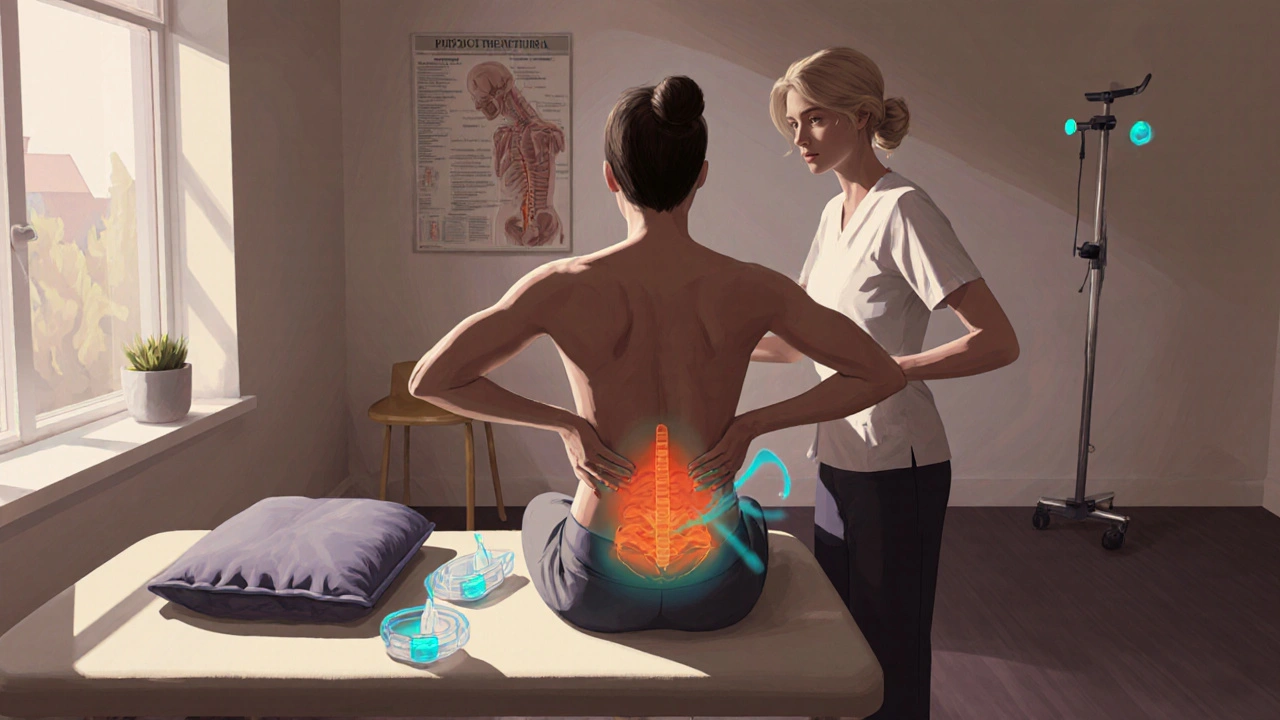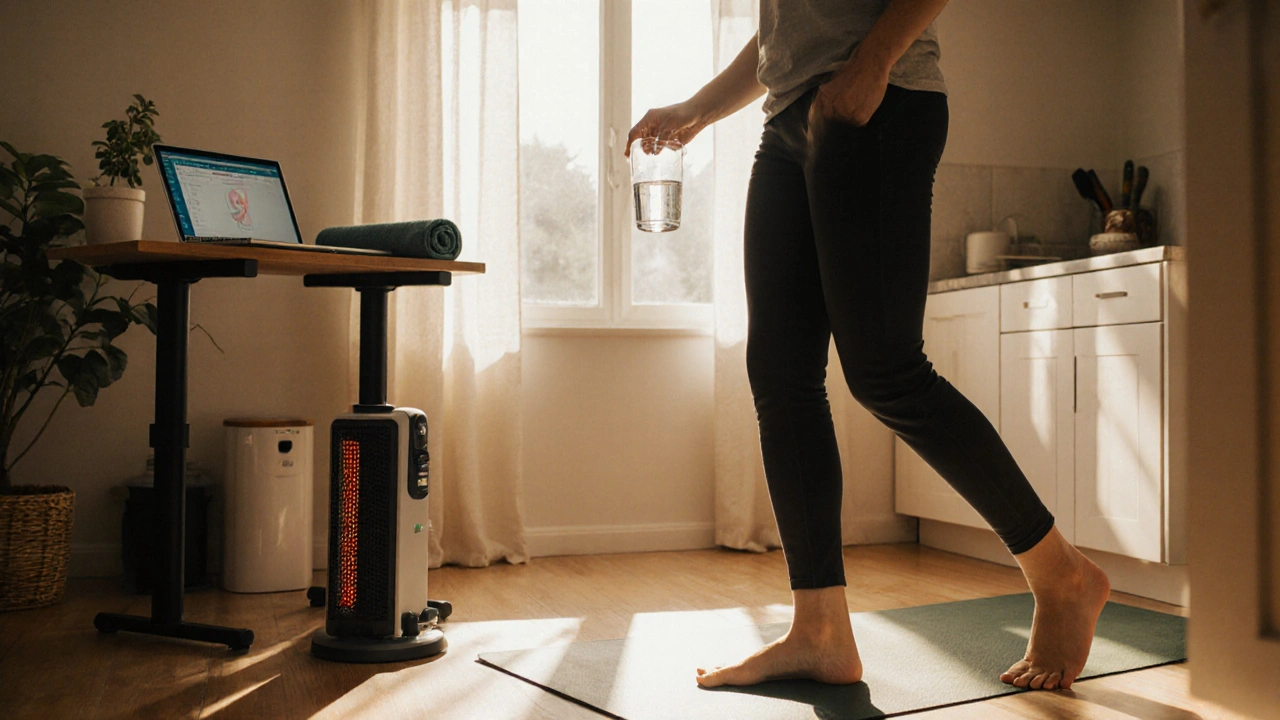Physical Therapy for Muscle Spasms: Benefits and Techniques

Muscle Spasm Relief Calculator
Spasm Relief Calculator
Heat Therapy Recommendations
Apply heat for 10-15 minutes to increase blood flow and muscle flexibility. Do not apply heat directly on inflamed skin.
Stretching Guidelines
Perform each stretch 2-3 times daily. Stop immediately if you feel sharp pain.
Personalized Recommendations
Your recommended plan includes a 10-15 minute heat application followed by 30-60 second stretches performed 3 times daily.
When a sudden, painful knot shoots through a muscle, it can feel like your body has turned against you. Those involuntary contractions, known as muscle spasms are uncontrolled, painful contractions of skeletal muscles that can last seconds to hours, often triggered by overuse, dehydration, or nerve irritation. While rest and over‑the‑counter meds provide temporary relief, many discover that physical therapy offers a longer‑lasting solution by targeting the root causes.
Understanding Muscle Spasms
Before diving into treatment, it helps to know why spasms happen. A muscle fiber receives an abnormal electrical signal, causing it to contract without the brain’s command. This can be the result of:
- Muscle fatigue from repeated activity
- Electrolyte imbalances (low potassium, magnesium, calcium)
- Pinched nerves or spinal misalignments
- Stress‑induced tension
When the spasm persists, it restricts blood flow, intensifies pain, and may lead to chronic tightness. Knowing the trigger guides the choice of therapy.
Why Physical Therapy Works
Physical therapy (PT) isn’t just a collection of exercises; it’s a science‑based approach that restores normal muscle function. A licensed physiotherapist a health‑care professional trained to assess, diagnose, and treat movement disorders uses assessment tools, manual skills, and evidence‑backed modalities to break the spasm cycle.
Key mechanisms include:
- Improving blood circulation - gentle movements and heat increase oxygen delivery, flushing waste products that keep fibers contracted.
- Resetting nerve signals - specific stretches and manual pressure calibrate the spinal and peripheral nerves, reducing errant firing.
- Restoring muscle length - prolonged shortening is corrected, preventing the muscle from snapping back into a contracted state.
- Teaching self‑management - patients learn ergonomic habits and home exercises that stop future spasms before they start.

Core PT Techniques for Muscle Spasm Relief
Below are the most common techniques you’ll encounter, each backed by clinical research and practical outcomes.
Stretching a set of lengthening maneuvers that target tight muscle groups to improve flexibility and reduce neuromuscular excitability
Static and dynamic stretches are prescribed based on the spasm’s location. Holding a stretch for 30‑60 seconds, three times per day, helps the muscle stay in a relaxed state.
Manual Therapy hands‑on techniques such as massage, joint mobilization, and myofascial release used to decrease tension and improve tissue mobility
Therapists apply firm but controlled pressure to the affected area, breaking down adhesions and encouraging the muscle fibers to reset. A typical session may include 10‑15 minutes of targeted massage followed by gentle joint mobilizations.
Trigger Point Therapy a precise method that isolates hyperirritable spots within a muscle knot and applies sustained pressure to release them
By locating a tender nodule and maintaining pressure for 30‑90 seconds, the therapist deactivates the offending nerve endings. Patients often report immediate pain reduction.
Heat Therapy the application of warmth (e.g., hot packs, infrared lamps) to increase tissue temperature and blood flow
Heat dilates blood vessels, delivering oxygen and nutrients while flushing out metabolites that keep the muscle contracted. A 10‑minute warm pack before stretching can double the effectiveness of the stretch.
TENS (Transcutaneous Electrical Nerve Stimulation) a low‑voltage electrical modality that interferes with pain signals and promotes muscle relaxation
Electrodes placed around the spasm emit gentle pulses, stimulating large‑diameter nerve fibers that block pain transmission. Most studies show a 30‑40% reduction in perceived pain after a 20‑minute session.
Exercise Therapy
Strengthening the surrounding muscle groups prevents overload on the spasm‑prone muscle. Low‑impact core and stabilizer exercises are introduced gradually, often starting with body‑weight movements and progressing to resistance bands.
Postural & Ergonomic Training
Improper posture places chronic strain on certain muscles, prompting spasms. PTs assess daily activities-desk work, lifting, sleeping-then provide adjustments like chair height, monitor placement, or pillow choice.
What to Expect in a Typical PT Session
- Initial Assessment: The therapist records medical history, evaluates range of motion, and identifies the spasm’s trigger points.
- Goal Setting: Together you set realistic targets - e.g., “reduce pain from 7/10 to 3/10 within two weeks.”
- Hands‑On Treatment: Using a combination of the techniques above (often 20‑30 minutes total).
- Education & Home Program: You receive a personalized stretch and strengthening plan, plus instructions on heat or TENS use at home.
- Follow‑Up: Progress is reassessed every 1‑2 weeks, and the program is tweaked as needed.
Most people notice a noticeable drop in pain after 2‑4 sessions, especially when they stick to the home program.
Self‑Care Tips to Keep Spasms at Bay
- Stay Hydrated: Aim for at least 2L of water daily; electrolytes are crucial if you sweat heavily.
- Warm‑Up Properly: Light cardio plus dynamic stretches before any strenuous activity reduces sudden muscle overload.
- Use Heat Wisely: Apply a warm pack for 10‑15 minutes before stretching, but avoid prolonged heat on inflamed tissue.
- Maintain Good Posture: Keep shoulders relaxed, lumbar support in place, and avoid staying in one position for more than 30minutes.
- Incorporate Gentle Movement: Even short walks or gentle yoga keep muscles from locking up.

Physical Therapy vs. Other Common Treatments
| Criteria | Physical Therapy | Medication (e.g., NSAIDs, muscle relaxants) | Massage Therapy | Acupuncture |
|---|---|---|---|---|
| Duration of Relief | Weeks to months (addressing root cause) | Hours to a few days | Hours to a day | Days to a week |
| Side‑Effect Risk | Low (mostly temporary soreness) | Gastrointestinal upset, drowsiness, dependence | Minimal, occasional bruising | Minimal, rare faintness |
| Cost per Session | $80‑$150 (often covered by insurance) | Variable prescription cost; may need multiple fills | $60‑$120 | $70‑$130 |
| Long‑Term Benefit | Improved strength, flexibility, and self‑management | Limited; does not correct underlying mechanics | Temporary muscle relaxation | Potential neuromodulation, evidence still emerging |
While each option can provide short‑term comfort, physical therapy stands out for its blend of immediate pain relief and lasting functional improvement.
Choosing the Right Physical Therapist
Not every clinic offers the specialized skills needed for muscle‑spasm management. Look for these credentials:
- Licensed PT with a specialty in orthopedics or sports medicine.
- Experience treating chronic muscle tension (ask about years of practice).
- Availability of modalities like TENS and ultrasound.
- Positive patient testimonials that mention “spasm relief” or “quick pain reduction.”
Ask a prospective therapist how they would combine stretching, manual therapy, and education for your specific situation. A clear, customized plan is a good sign.
Frequently Asked Questions
Can physical therapy cure chronic muscle spasms?
Physical therapy may not "cure" every spasm forever, but it can dramatically reduce frequency and intensity by fixing the underlying muscle imbalances, improving circulation, and teaching lasting self‑care strategies.
How many sessions are usually needed?
Most patients see noticeable improvement after 2‑4 weekly visits, provided they follow the home exercise plan. Complex cases may require 8‑12 sessions.
Is it safe to use heat before stretching?
Yes. Applying heat for 10‑15 minutes raises muscle temperature, making fibers more pliable and reducing the risk of strain during stretching.
Do I need a doctor’s referral?
In most states you can book an appointment directly, but insurance plans sometimes require a referral for coverage. Check your policy before scheduling.
Can I combine physical therapy with medication?
Absolutely. Many therapists coordinate with physicians so you can use short‑term muscle relaxants for acute flare‑ups while the PT program builds long‑term resilience.

20 Comments
Muscle spasms can be debilitating, and addressing them promptly is essential for optimal recovery.
Physical therapy offers a systematic approach that combines assessment, targeted interventions, and patient education.
An initial comprehensive evaluation allows the therapist to identify underlying biomechanical contributors.
This may include postural imbalances, neuromuscular dyscoordination, or localized tissue restrictions.
Following assessment, a personalized treatment plan is devised to address the specific etiology.
Heat therapy is frequently employed to augment tissue extensibility prior to stretching.
The application of heat for ten to fifteen minutes increases intramuscular blood flow.
Enhanced circulation facilitates the delivery of oxygen and removal of metabolic waste products.
Subsequent static stretching, held for thirty to sixty seconds, promotes sarcomere lengthening.
Repeated stretch cycles, performed three times daily, have been shown to reduce spasm frequency.
Manual therapy techniques, such as myofascial release, further assist in interrupting pain signaling.
Trigger point deactivation through sustained pressure can provide immediate analgesia.
Incorporating TENS modalities offers an additional avenue for modulating nociceptive input.
Strengthening of antagonistic muscle groups restores functional balance and prevents recurrence.
Education on ergonomic practices empowers patients to maintain improvements independently.
Adherence to the prescribed home program is the decisive factor that determines long‑term success.
It is simply unethic to rely on quick‑fix pills when a proper PT plan is availabel.
People must take responsablity for their bodies instead of seeking numborous prescriptions.
The medical establishment pushes drugs that mask pain, not fix the root cause.
Choosing physiotherapy demonstrates a commitment to long‑term health and moral integrity.
Hey folks, totally get how frustrating those sudden knots can be – they show up just when you’ve got a deadline looming. It’s like your muscles have a mind of their own, trying to tell you to slow down. If you’re feeling the tension, a gentle warm‑up and a few mindful breaths can make a world of difference. Remember, the body’s always sending signals; listening is the first step toward easing those spasms.
Wow, another “miracle cure” article. As if applying a hot pack magically erases years of neglect. I bet the therapist charges an arm and a leg for a 20‑minute session while you’re left with a bill and the same knot. Let’s be honest, most of this is just marketing fluff wrapped in scientific jargon.
Great rundown! I’ve seen clients go from a constant 8/10 knot to almost pain‑free after just a few weeks of consistent heat + stretch combos. The key is really showing up for the home program; you can’t expect miracles if you skip the daily stretches.
Also, remind them to stay hydrated and keep an eye on electrolyte intake – it’s a game‑changer for preventing new spasms.
Keep the momentum going, and you’ll watch those spasms disappear faster than you think!
I think the article is helpful, but maybe add a tip about taking breaks when working at a desk. Simple stuff can go a long way.
Sounds solid. I’ll try the heat before stretching next time.
Whoa, this is a fantastic piece! The way you’ve broken down each modality makes it so easy to follow. I particularly love the emphasis on patient education – it’s the backbone of sustainable recovery.
One suggestion: maybe include a quick FAQ about common contraindications for heat therapy, just to keep everyone safe. Overall, stellar work and very motivating!
Indeed, the cultural perception of “toughing it out” often discourages people from seeking PT. By sharing this info, we’re helping to shift that narrative and empower more folks to take proactive steps toward wellness.
Wow, thanks for the detailed guide! 😊 It really helps to see the steps laid out so clearly. I’ll definitely add the heat‑before‑stretch routine to my nightly regimen.
Oh great, another “must‑read” post that tells us to warm up before we stretch. As if we didn’t already know that from every gym poster ever. 🙄 Still, at least it’s written in plain English.
From a biomechanical perspective, the integration of proprioceptive feedback loops is paramount; nevertheless, the article glosses over the necessity of neuromuscular re‑education protocols, which are essential for long‑term spasm mitigation.
Overall a decent overview, but I’d have liked more references to peer‑reviewed studies.
Therapy? Nah, just get a good massage and you’re set.
I appreciate the balanced approach here – it’s both informative and encouraging. Keeping the tone upbeat helps people actually follow through with the home program.
Good info but a bit too long for me.
While the article is thorough, one must question whether the recommended frequency of sessions is realistic for the average working adult. The authors seem to assume unlimited time and resources, which is not the case for many.
Spot on! Your colorful explanations make the science feel accessible. Keep sprinkling those vivid analogies – they really help the mind picture what’s happening in the muscles.
In the grand tapestry of human health, physical therapy stands as a beacon of disciplined mastery, guiding the restless flesh toward harmonious motion.
Those who dismiss it in favor of fleeting pharmacologic escapes are merely chasing shadows, neglecting the profound symphony of biomechanics and neurophysiology.
Let us, therefore, elevate the conversation, recognizing PT not as a mere option but as an essential pillar of holistic longevity.
Honestly, all this PT talk feels like international fluff. In our country we just keep moving and the muscles sort themselves out. No need for all that fancy stuff.